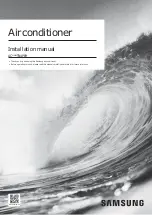
11
English
Installation Pr
oc
edur
e
Step 7 Connecting the assembly pipes
to the refrigerant pipes
There are two refrigerant pipes of different diameters :
• A smaller one for the liquid refrigerant.
• A larger one for the gas refrigerant. The inside of
copper pipe must be clean and has no dust.
1
Remove the pinch pipe on the pipes and connect the
assembly pipes to each pipe, tightening the nuts, first
manually and then with a torque wrench, a spanner
applying the following torque.
Spanner
Torque
wrench
Flare nut
Union
ߥ
ߥ
ߤ
ߣ
Outer Diameter (mm)
Torque (N•m)
Ø6.35
14 to 18
Ø9.52
34 to 42
Ø12.70
49 to 61
Ø15.88
68 to 82
Ø19.05
100 to 120
(1 N•m=10 kgf•cm)
NOTE
• If the pipes must be shortened, see
Step 6 Cutting
and flaring the pipes
on page
10
.
2
Be sure to use an insulator thick enough to cover the
refrigerant tube to protect the condensate water on
the outside of the pipe falling onto the floor and to
improve the efficiency of the unit.
3
Cut off any excess foam insulation.
4
Make sure that there are no cracks or waves on the
bent area.
5
It would be necessary to double the insulation
thickness (10 mm or more) to prevent condensation
even on the insulator when if the installed area is
warm and humid.
CAUTION
• Connect the indoor and outdoor units using pipes with
flared connections (not supplied). For the lines, use
insulated, unwelded, degreased and deoxidized copper
pipe (Cu DHP type to ISO 1337 or UNI EN 12735-1), suitable
˙ͱθͱΧʪθɇϩ̈͝˝ΧθʪϑϑЇθʪϑͱ˙ɇϩ̷ʪɇϑϩߦߤऌđťɇɇ͝ʒ˙ͱθɇɵЇθϑϩ
ΧθʪϑϑЇθʪͱ˙ɇϩ̷ʪɇϑϩߤߢߩऌđťɇAͱΧΧʪθΧ̈Χʪ˙ͱθ˵цʒθͱࣛ
sanitary applications is completely unsuitable.
• For sizing and limits (height difference, line length, max.
bends, refrigerant charge, etc.) see the outdoor unit
installation manual.
• All refrigerant connection must be accessible, in order to
permit either unit maintenance or removing it completely.
• If the pipes require brazing, make sure that oxygen free
nitrogen (OFN) is flowing through the system.
• Nitrogen blowing pressure range is 0.02 to 0.05 MPa.
Step 8 Performing the gas leak test
To identify potential gas leaks on the indoor unit, inspect
the connection area of each refrigerant pipe using a leak
detector for R-410A.
Before recreating the vacuum and recirculating the
refrigerant gas, pressurize the whole system with
nitrogen (using a cylinder with a pressure reducer) at a
pressure above 0.2 MPa, less than 4 MPa (gauge) in order
to immediately detect leaks on the refrigerant fittings.
Made vacuum for 10 minutes and pressurizing system
with nitrogen.
Insulator
Liquid side
Gas side
Содержание AC018TN4PEH
Страница 32: ......












































